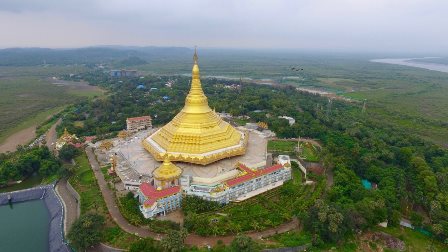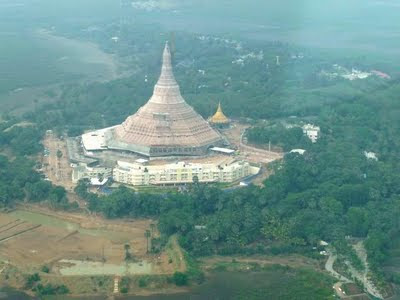In many ways, the original architect of the Global Pagoda is Sayagyi U Ba Khin (1899-1971). The foremost Vipassana teacher of his time, Sayagyi U Ba Khin was instrumental in Vipassana returning to India, the Dhamma land of its origin. In 1969, he sent one of his students Sayagyi U S.N.Goenka to India as his representative to teach Vipassana. In the following decades, the Ganges of Dhamma spread widely not only in India, but all over the world.
The Global Pagoda that is modelled on the famous Shwedagon Pagoda in Rangoon, stands also as a monumental mark of gratitude to Sayagyi U Ba Khin and Burma, the country that preserved Vipassana in its purity after it had been lost to India for millennia.
The Global Pagoda that is modelled on the famous Shwedagon Pagoda in Rangoon, stands also as a monumental mark of gratitude to Sayagyi U Ba Khin and Burma, the country that preserved Vipassana in its purity after it had been lost to India for millennia.

The Shwedagon Pagoda in Rangoon, Burma. The height of the Global Pagoda in Mumbai, India, has been kept slightly lower than that of the Shwedagon, as mark of gratitude and respect to Burma that preserved the teaching of Vipassana in its purity for millennnia.
"Sayagyi's way was not the way of scholars. Every word that he spoke came from his own experience. Therefore his teachings have the life of experience within them, and this is why every word said by him was very powerful and encouraging to his students. He wrote little, and he spoke little; but still, many students were benefited by his teaching."
Below are some inspiring sayings of Sayagyi U Ba Khin, collated by the Vipassana Research Institute:
" The world is facing serious problems. It is just the right time for everyone to take to Vipassana meditation and learn how to find a deep pool of quiet in the midst of all that is happening today."
"The Dhamma can stand the test of those who are anxious to do so. They can know for themselves what the benefits are."
"The more one is attached to self, the greater is the suffering.
"To imagine that good can be done by the means of evil is an illusion, a nightmare."
"A balanced mind is necessary to balance the unbalanced mind of others."
"Only those who take to meditation with good intentions can be assured of success. With the development of the purity and the power of the mind backed by the insight into the ultimate truth of nature, one may be able to do a lot of things in the right direction for the benefit of mankind."
"Just as the light of a candle has the power to dispel darkness in a room, so also the light developed in one man can help dispel darkness in several others."
"For progress in Vipassana meditation, a student must keep knowing anicca as continuously as possible."
"Dhamma eradicates suffering and gives happiness. Who gives this happiness? It is not the Buddha but the Dhamma, the knowledge of anicca within the body, which gives this happiness. That is why you must meditate and be aware of anicca continually."
"What is happiness? For all that science has achieved in the field of materialism, are the peoples of the world happy? They may find sensual pleasures off and on, but in their hearts of hearts, they are not happy when they realise what has happened, and what may happen next. Why? This is because, while man has mastery over matter, he is still lacking in mastery over his mind."
"Anicca is inside of everybody. It is within reach of everybody. Just a look into oneself and there it is. Anicca (impermanence) is, for the householder, the gem of life which he will treasure to create a reservoir of calm and balanced energy for their own well-being and for the welfare of society."
"Anicca when properly developed will solve almost all your problems. It might not even be necessary for you to ask questions for answers. As the appreciation of anicca grows, so will the veil of ignorance fade away. When the way becomes clear for right understanding, doubts and fears will disappear automatically. You will then see things in the true perspective."
"Continuous awareness of anicca, and so of dukkha (suffering) and anattā (insubstantiality), is the secret of success."



